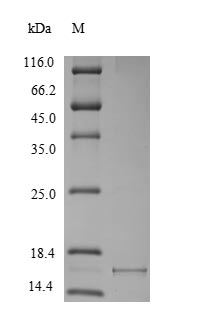The DNA fragment encoding the 1-140aa of the Macaca fascicularis SNCA protein was fused with N-terminal 6xHis tag gene and then was inserted into the expression vector, which was subsequently transfected into the yeast cells for expression. The resulting product was further purified to obtain the recombinant Macaca fascicularis SNCA protein. The purity of this recombinant SNCA protein is greater than 90% assessed by Bandscan software analysis combined with SDS-PAGE. This recombinant SNCA protein showed a band on the gel with a molecular weight of approximately 17 kDa.
In light of recent discoveries, researchers demonstrated that genetic triplication of the SNCA locus causes Parkinson disease. Another evidence discovered that the inhibition of SNCA enhances α‐synuclein in Parkinson's disease. SNCA is determined as one of susceptibility genes for Parkinson's disease. Albeit less is known about the mechanism of SNCA, SNCA is widely found to manipulate the mobility of synaptic vesicles. This regulation process is possible to disrupt the synaptic vesicle recycling and neurotransmitter release.






